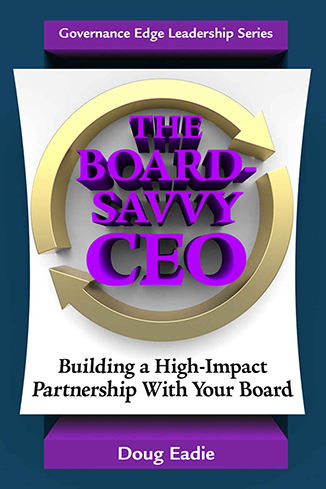 “Well, it’s all about policy making. In a nutshell, that’s what the board does, right – enact policies?” I’ve quoted verbatim from one of hundreds of board member interviews I’ve conducted over the years, usually in preparation for a board-CEO-executive team retreat I’ve been hired to facilitate. It’s a typical response to a question I always ask early in my interviews: “How would you describe the governing work your board does – your board’s governing role – in a nutshell?”
“Well, it’s all about policy making. In a nutshell, that’s what the board does, right – enact policies?” I’ve quoted verbatim from one of hundreds of board member interviews I’ve conducted over the years, usually in preparation for a board-CEO-executive team retreat I’ve been hired to facilitate. It’s a typical response to a question I always ask early in my interviews: “How would you describe the governing work your board does – your board’s governing role – in a nutshell?”
Actually, there’s a small grain of truth in the description of a nonprofit board’s role as “policy-making.” Boards do every so often fashion and enact broad rules we call “policies.” But policy making per se is such a small part of the complex and high-stakes work that boards do when they govern that saying your board is a policy-making body is a perfect example of the kinds of erroneous assumptions I’ll be talking about in a new series of articles at www.extraordinaryceo.com: “8 Insidious Foes of a Solid Board-CEO Partnership.”
I’m sure many of you are wondering how I segued from an erroneous assumption to an “insidious foe.” There are two reasons. First, the erroneous assumption that what boards basically do is make policies can, as I’ll explain in my next article in this series, damage the board-CEO working relationship. Therefore, it’s by definition a foe that, in my experience, often leads to a rupture in this most precious and always fragile relationship and to the premature departure of the CEO.
“OK,” you’re likely to be saying to yourself at this point, “Doug might very well be right that inadequately defining the board’s role could do damage to the board-CEO relationship and might even do the CEO in – I’ll see what he says in his second article before I buy the notion completely – but what’s ‘insidious’ about this so-called foe?” What’s insidious about this – and the other erroneous assumptions I’ll be writing about in this series – is that they’re not obvious foes of a solid board-CEO partnership. This and the other assumptions I’ll be describing sound benign enough, even if they’re not technically correct. In several cases they’re actually what we call “conventional wisdom.” So they’re a well-hidden enemy that operates by stealth – often working their way so unobtrusively that by the time board members and the CEO recognize the danger, it’s too late to avert serious damage. As you all know, this is the standard definition of “insidious.”
I’m pleased to report that a member of this blog’s CEO Advisory Committee will post a commentary after each of my articles in this series, sharing their experience in dealing with the particular foe I’m describing – either in an article or a podcast. And, of course, I’m hoping that each of my articles and the follow-up commentaries in this series will stimulate robust reader discussion.
Next up: Insidious Foe #1: Governing is very simply policy-making.





